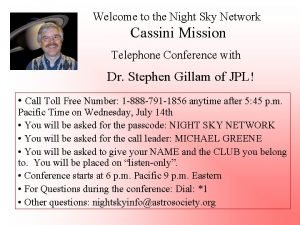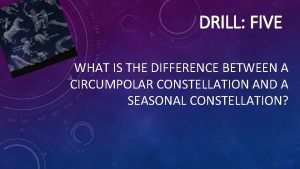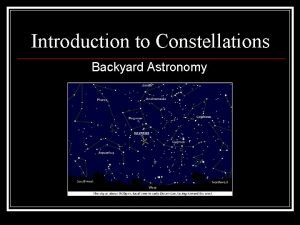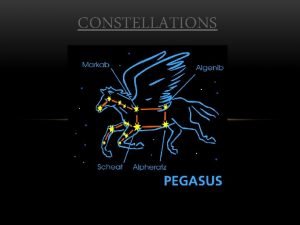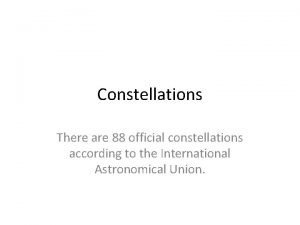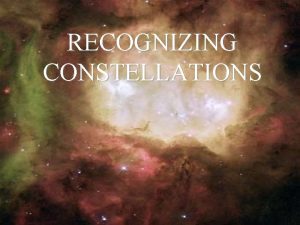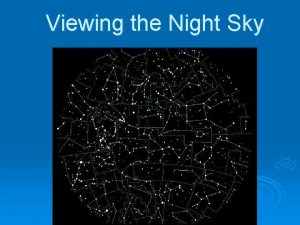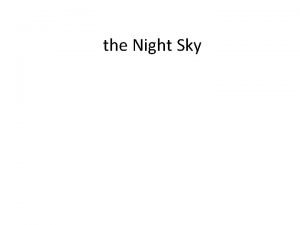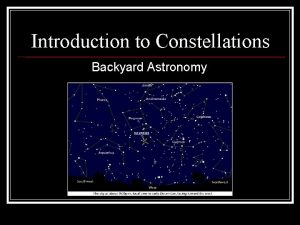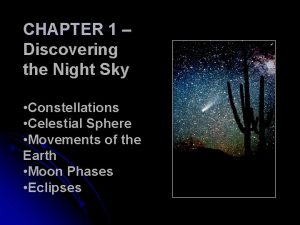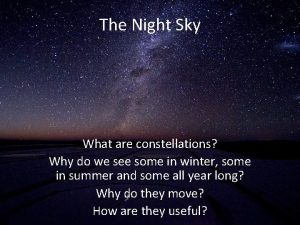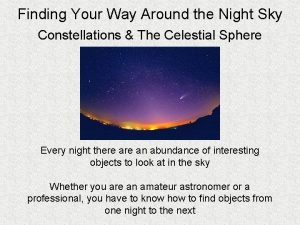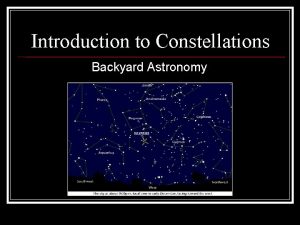Constellations Patterns in the Night Sky Constellation A












- Slides: 12

Constellations

Patterns in the Night Sky � Constellation: ◦ A group of _____ that seem to form a distinctive _________ in the sky. ◦ The stars look close to each other, but may actually be ________ apart! � Light-year ◦ ◦ (ly): A unit of _________. Represents the distance that light travels in one _______. Light travels at ________ km/s. One light-year is about _________ km.

Solve these problems: 1. Polaris, also known as the North Star, is 400 ly from Earth. Calculate the distance from Polaris to Earth in kilometers. 2. Calculate how long it takes light to travel from Polaris to Earth in seconds.

Solve these problems: 1. Calculate how long it takes light to travel from Polaris to Earth in a) Minutes b) Hours c) Days d) Years

Notice: Constellations look very different from earth than they do in space! This is Cassiopeia as it appears from Earth as well as how its stars appear to be unrelated in space.

Apparent Magnitude � Star Map: ◦ A diagram that shows constellations and individual stars. ◦ Larger the dot, the ______ the star. � Apparent �A Magnitude: star’s brightness as seen from Earth. � Affected by two factors: 1. Actual _______ of star 2. ________ from Earth

Names of Constellations � The International Astronomical Union (IAU): ◦ Union responsible for naming and classifying _________ objects. ◦ Lists 88 official ___________. � Many of the constellation names, especially in the _______________, are ancient _______ and _______ names that represent ___________ figures. ◦ Example: Cassiopeia is Greek for Seated Queen. ◦ Example: Capricornus is Latin for sea goat.

The Big Dipper � Different cultures interpret the same constellations in different ways. For example, the Big Dipper! ◦ ◦ Ancient Chinese: Chariot for the emperor of the heavens. Early Egyptians: Thigh & Leg of a bull North American Aboriginals: bowl is a bear Snohomish: three hunters chasing four elk

Polaris & The Pointer Stars � Big Dipper’s two end stars are called the ___________ because they point towards _______ (the ______). ◦ For thousands of years, long before the invention of the ________, people in the northern hemisphere used Polaris to tell ________. ◦ Earth’s ________ points to Polaris. ◦ As Earth rotates, Polaris does not appear to move. ◦ If you can see Polaris, you know which way is north – then you can determine east, south, and west.

Viewing Different Constellations � Due to Earth’s revolution around the _______, you see different ________ in the evening sky at _________ times of the year.

� The constellations that you can see also depend on your ________. As you move _______, constellations along the southern horizon slip below the horizon so you cannot see them. � Latitude: ◦ The location above or below the equator.

Homework 1) Page 282 #1 (look up the word asterism), #2 -7, #8 (use figure 7. 8 as inspiration). 2) Do the following activity: 1) Download the Sky Map App. 2) Find Polaris on the sky map, and if possible (and only safely, with an adult), go outside and try to find Polaris in the actual night sky. Does the sky map match up to what you actually see? _________ 3) List 5 constellations or stars that you can see on the sky map that surround Polaris. ______, _____________, ________________. 4) Can you find any planets on the sky map? If yes, which ones? _____________________.
 There are times when the night sky glows summary
There are times when the night sky glows summary Night sky network
Night sky network Five circumpolar constellations
Five circumpolar constellations Constellations defintion
Constellations defintion Constellations tumblr
Constellations tumblr Constellations
Constellations Les constellations les plus connues
Les constellations les plus connues What are constellations
What are constellations 88 official constellations
88 official constellations Yujin constellations
Yujin constellations Pretestp
Pretestp What constellations can you see all year round
What constellations can you see all year round Are constellations capitalized
Are constellations capitalized

